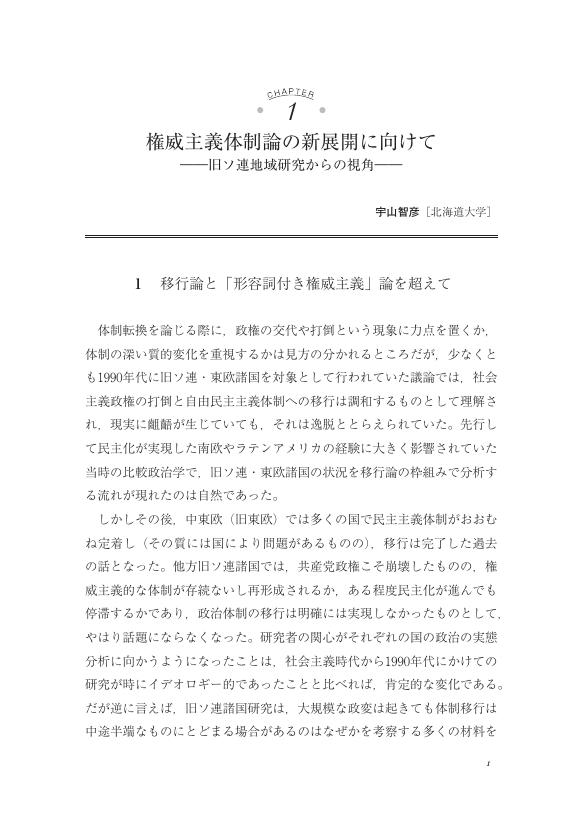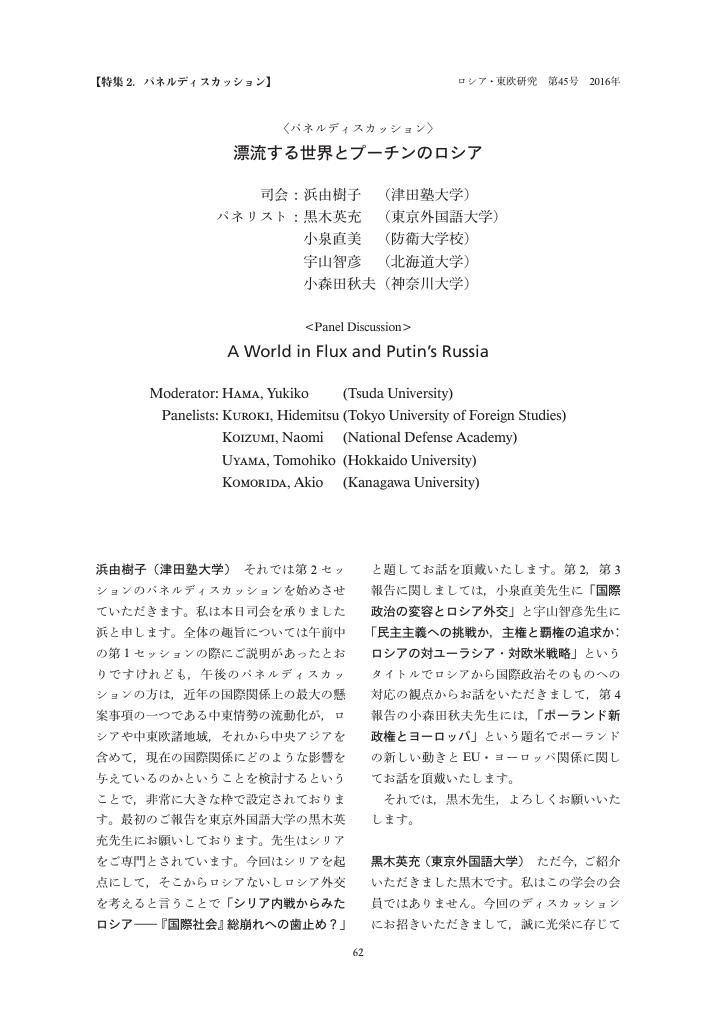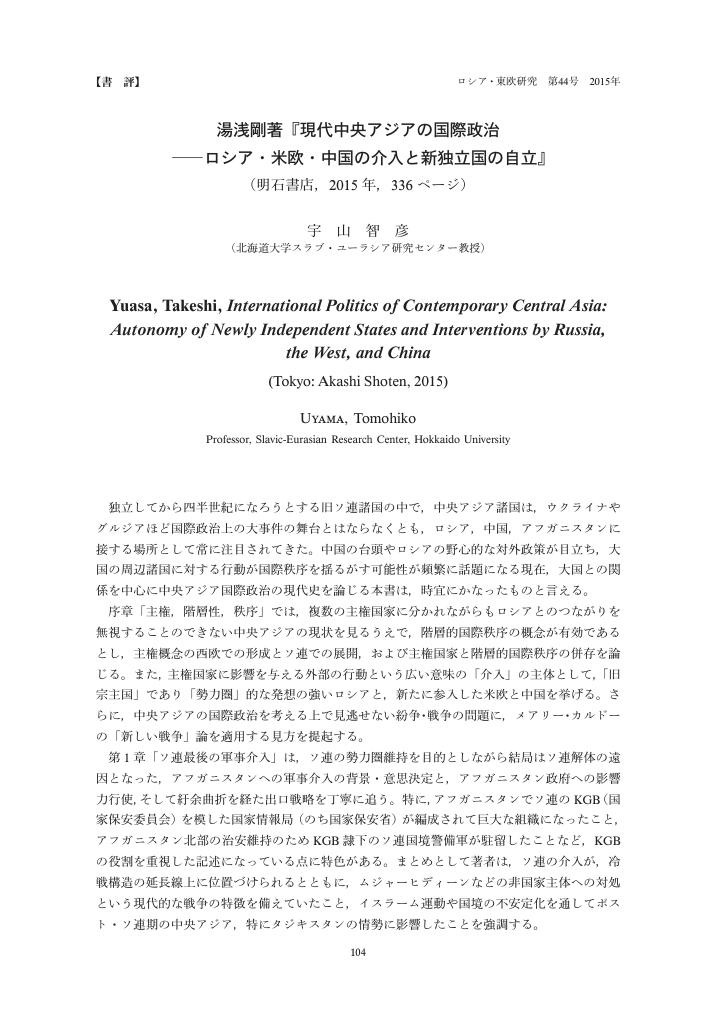6 0 0 0 OA インタビューで知る研究最前線 第2回
- 著者
- 宇山 智彦 樋渡 雅人 熊倉 潤 地田 徹朗
- 出版者
- 独立行政法人 日本貿易振興機構アジア経済研究所
- 雑誌
- アジア経済 (ISSN:00022942)
- 巻号頁・発行日
- vol.61, no.3, pp.61-96, 2020-09-15 (Released:2020-10-14)
- 参考文献数
- 50
- 著者
- 根本 敬 泉谷 陽子 磯崎 典世 井上 あえか 宇山 智彦 礒崎 敦仁 粕谷 祐子 横山 豪志 石塚 二葉 新谷 春乃 中野 亜里
- 出版者
- 上智大学
- 雑誌
- 基盤研究(B)
- 巻号頁・発行日
- 2020-04-01
本研究は権威主義体制の持続という現代世界を特徴づける検討課題を設定し、その中でも「建国の父」という正統性シンボルに着目して、アジア諸国(計8か国)を対象に比較分析を行うものである。主に歴史学と比較政治学のディシプリンを活用し比較定量分析による一般化可能な論点を抽出することも目指す。権威主義体制、ナショナリズム、歴史修正主義などの研究分野への貢献を視野に入れている。具体的な問いは次の2つである。(1)「建国の父」という正統性シンボルが、本人およびその後の後継エリートによってどのように構築され、継承、変化してきたのか(2)「建国の父」と権威主義体制の持続とのあいだにはいかなる関係があるのか
- 著者
- 宇山 智彦 BEATRICE Penati PENATI Beatrice FENATI Beatrice
- 出版者
- 北海道大学
- 雑誌
- 特別研究員奨励費
- 巻号頁・発行日
- 2009
当初はウズベキスタンの地方文書館で史料調査を行う計画であったが、近年、外国人研究者にウズベキスタンの文書館の利用許可が非常に下りにくくなっているため、実現できなかった。その代わり、モスクワのロシア国立社会政治史文書館(RGASPI)で、ウズベキスタンの地方の党組織から共産党中央委員会中央アジア・ビューローに送られた文書を閲覧した。その結果、土地水利改革が、モスクワからの押しつけというよりも、地方からの要請で行われた面が大きいという仮説を裏付けることができた。前年度までの作業と合わせ、土地水利改革の前史(ロシア帝国期の土地調査・税制を含む)、政策立案の方法、改革に関与した諸組織・指導者、改革の経済的・社会的影響を解明し、研究の目的をほぼ達することができたと言える。研究分担者は2011年8月にカザフスタンのナザルバエフ大学助教授となり、日本を離れたが、研究成果の取りまとめと発表はその後も続けている。成果の一部は、ESCAS(欧州中央アジア研究学会)などヨーロッパ各地の学会・セミナーで発表した。また、1920年代のネップ期に中央綿作委員会が、金融・商業・食料供給・投資を含むウズベキスタン経済のさまざまな分野において果たした役割と、他の諸機関との競争関係を分析した論文が、2012年内にフランスのCahiers du Monde Russe誌に掲載されることが決定した。また、ロシア革命から農業集団化前夜までの、ウズベキスタンにおける土地水利改革を含む農業・経済政策と社会・環境変化についてのモノグラフを執筆中で、遠からず完成する予定である。
2 0 0 0 OA CHAPTER 1 権威主義体制論の新展開に向けて ――旧ソ連地域研究からの視角――
- 著者
- 宇山 智彦
- 出版者
- 日本比較政治学会
- 雑誌
- 日本比較政治学会年報 (ISSN:21852626)
- 巻号頁・発行日
- vol.16, pp.1-25, 2014 (Released:2020-03-16)
- 参考文献数
- 11
2 0 0 0 OA 「個別主義の帝国」ロシアの中央アジア政策 : 正教化と兵役の問題を中心に
- 著者
- 宇山 智彦
- 出版者
- 北海道大学スラブ研究センター
- 雑誌
- スラヴ研究 (ISSN:05626579)
- 巻号頁・発行日
- vol.53, pp.27-59, 2006
This paper aims to challenge various traditional views of the Russian Empire: that it was a ruthless "Russirier"; that it had a universalistic and hannonious principle for integration; that in its last stage the empire was transforming itself to a nation-state. I try to do so by examining history of two unsuccessful projects of the Russian Empire in Central Asia, that is, Christianization as propagation of a universalistic ideology, and military conscription as a tool of nation building. Debates on Christianization of Central Asians began in the 1860s. The Kazakhs and Kyrgyz were considered to be half-Muslims, unlike Tatars and Uzbeks ("Sarts"), and therefore relatively easy targets for propagation of Orthodoxy. Opponents to Christianization, however, maintained that it could antagonize Muslims (including Kazakhs and Kyrgyz) and cause disorders. In Turkistan, whose Muslim sedentary population was called "fanatic," Governor-General Kaufman practically prohibited missionary activities. He did not object to General Kolpakovskii's support to missionary activities among the Kazakhs, Kyrgyz and Kalmyks in Semirech'e, but the results of proselytism there were meager. Throughout the second half of the nineteenth century, only about one thousand Central Asian natives converted to Orthodoxy. The Tsar's manifesto of religious toleration in April 1905, which conditionally sanctioned conversion from Orthodoxy to other faiths, dealt a final blow to missionaries. Most of the baptized Central Asians went back to Islam and almost no one was newly converted after this. Scenes of the revolt of 1916 in Semirech'e, where rebels killed monks and Russians in arms gathered in church squares, were highly symbolic in the sense that the Orthodox Church, after all, belonged to the Russians, not the native peoples of Central Asia. The second part of the paper examines discussions on military conscription of Central Asians, who were exempted from it as inorodtsy (aliens). One of the arguments for conscription was the necessity of strong cavalry in preparation for possible wars with China and Afghanistan. Officers cited the high quality of Central Asian nomads as horse-riders, and emphasized that military service was a powerful tool of Russification and the best school to teach public order. Again, a major argument against military conscription was the possibility of disturbances. Many officers feared that military service would give the population leaders for possible insurrections. Some also insisted that the conditions of military service radically contradicted the mode of life of nomads who were accustomed to unlimited freedom. Overall, they alleged that Central Asians' "low blagonadezhnost' (trustworthiness) and grazhdanstvennost' (level of civic development)" was a fundamental obstacle to their conscription. Officers evaluated the combat ability of various ethnic groups differently. They generally regarded the sedentary population of Turkistan as cowards and called the Kazakhs excellent horsemen but not necessarily courageous warriors, but were fascinated by the splendid quality of the Turkmen as warriors. This fascination gave birth to the exceptional case of the Turkmen irregular cavalry. After 1905, Russian nationalists increasingly asserted that Russians bore an unjustly heavy burden in defending the empire, and called for drafting inorodtsy. During World War I, the Ministry of War drew up a bill to draft almost all the ethnic groups of the empire, but the Ministry of Interior nixed it. In 1916, the government suddenly decided to mobilize Central Asians not as soldiers but as laborers, which gave rise to a huge revolt. On the whole, discussions of military service by Central Asians (which continued for more than half a century) took the character of a chicken-and-egg problem. Would military service enhance their grazhdanstvennost' and Russify them, or did military service require a sufficiently high level of grazhdanstvennost' and Russification? Eventually, officials who mistrusted inorodtsy always managed to block conscription proposals. Reasons for the failure of the two projects were partly rooted in the Russian bureaucracy. Permission for missionary activities was often given after much delay or was not given at all. The Orthodox Church itself had a hierarchical and bureaucratic structure. By contrast, Muslim mullahs went into the steppe as peddlers and healers without bureaucratic procedures, and could easily adapt themselves to local society. Moreover, officials' grasp of local situations was shaky. They thought that native administration of volosts and villages formed an "impermeable curtain" and hindered them from knowing Muslim life. The most important point of my analyses is the particularistic features or Russian policy. Many officials shared the view that it was desirable to Russify Central Asians, but there was hardly any resolute determination to carry out concrete measures for this purpose. They were interested in passive maintenance of stability rather than active integration and Russification. They did not just differentiate Central Asians from the Russians, but also differentiated nomads from sedentary people, the steppe oblasts from Turkistan. Officials were obsessed with the idea that they had to discuss the pros and cons of a policy measure in relation to every single region or ethnic group. This attitude of alienating (or otherizing) Central Asians and classifying them is what I call particularism. Particularism partly derived from a character inherent to autocratic empires. In such empires, a subjugated country or people pledged allegiance separately to the monarch, and were given peculiar privileges and obligations. But in the second half of the nineteenth and early twentieth centuries, quasi-academic discourses on ethnic characters added new meanings to particularism. Courageousness, warlikeness, trustworthiness and grazhdanstvennost' were considered to be characters of ethnic groups rather than qualities of individuals. This tendency to attach excessively great importance to ethnic characters was a product of Orientalism and the mind of the colonial state.
1 0 0 0 OA 漂流する世界とプーチンのロシア
- 著者
- 宇山 智彦
- 出版者
- ロシア・東欧学会
- 雑誌
- ロシア・東欧研究 (ISSN:13486497)
- 巻号頁・発行日
- vol.2015, no.44, pp.104-107, 2015 (Released:2017-08-18)
- 著者
- 宇山 智彦
- 出版者
- 一般財団法人 日本国際政治学会
- 雑誌
- 国際政治 (ISSN:04542215)
- 巻号頁・発行日
- vol.2020, no.201, pp.201_98-201_113, 2020-09-15 (Released:2022-03-31)
- 参考文献数
- 63
There is a paradox in Central Asian politics of the late Soviet period: Independence movements were feeble and political elites were basically loyal to Moscow, but the leaders of the republics swiftly decided to declare independence during the fall of the Soviet Union. While contemporary observers underlined nationalism shared not only by activists of national movements but also by leaders of the republican communist parties, it was hardly a major concern for the latter. Research on the Brezhnev era shows that political elites in Central Asia gained limited but significant autonomy during that period, but this fact alone cannot explain the process of independence. This study reexamines the relationships between the national question and politics in the Central Asian republics, especially the impacts of the four major conflicts: the Almaty events of 1986, the Ferghana events of 1989, the Dushanbe events and the Osh events of 1990. We argue that these events triggered or accelerated the transformation of politics in the republics, adding elements of mass politics to Brezhnevite boss politics in narrow elite circles and creating the republics’ own political arenas. The emergence of these arenas did not mean a growing orientation toward independence per se, but the violent suppression of demonstrations and riots, combined with repercussions of defamatory campaigns against nationalism in the early period of perestroika, which made the relationships between Moscow and Central Asia uneasy, gave centrifugal force to these arenas.At the same time, these events had varied influence on the standing of political leaders and on intra-elite cohesion and cleavages. In Kazakhstan, Gennadii Kolbin, whose appointment caused the Almaty events, had no other choice than to cooperate with Kazakh elites, who remained cohesive and subsequently supported the next leader, Nursultan Nazarbaev. In Uzbekistan, the Ferghana events facilitated the ascent of Islam Karimov, who later concentrated power in his own hands on the pretext of keeping the relative post-conflict stability. In Kyrgyzstan, the Osh events discredited Absamat Masaliev and created the opportunity for the academician Askar Akaev to become president, but it also deepened intra-elite cleavages and paved the way for the perpetuation of “pluralism by default.” In Tajikistan, Qahhor Mahkamov remaining in power despite his mishandling of the Dushanbe events seriously deepened intra-elite cleavages that later developed into a civil war. Thus, the national question and conflicts during perestroika preconditioned diverse power relations in the post-Soviet Central Asian states. At the same time, the experience of conflict strengthened the political leaders’ desire to restore order and boss politics, now without Moscow’s tutelage, leading to an inclination toward authoritarianism.
- 著者
- 宇山 智彦
- 出版者
- 日本国際政治学会 ; 1957-
- 雑誌
- 国際政治 (ISSN:04542215)
- 巻号頁・発行日
- no.201, pp.98-113, 2020-09
1 0 0 0 漂流する世界とプーチンのロシア
1 0 0 0 ロシア革命百周年記念討論会
- 著者
- 和田 春樹 塩川 伸明 宇山 智彦 池田 嘉郎 長縄 宣博 松里 公孝
- 出版者
- ロシア史研究会
- 雑誌
- ロシア史研究 = История России (ISSN:03869229)
- 巻号頁・発行日
- no.99, pp.26-61, 2017
1 0 0 0 現代中央アジア論 : 変貌する政治・経済の深層
- 著者
- 岩崎一郎 宇山智彦 小松久男編著
- 出版者
- 日本評論社
- 巻号頁・発行日
- 2004
1 0 0 0 OA 比較植民地史:近代帝国の周縁地域・植民地統治と相互認識の比較研究
- 著者
- 宇山 智彦 平野 千果子 秋田 茂 前川 一郎 河西 晃祐 小沼 孝博 水谷 智 長縄 宣博 天野 尚樹 中山 大将
- 出版者
- 北海道大学
- 雑誌
- 基盤研究(A)
- 巻号頁・発行日
- 2013-10-21
近代帝国の植民地および脱植民地化の歴史を、比較と関係性の視角から研究した。帝国権力と周縁・植民地社会を結ぶ媒介者・協力者の役割、植民地の知識人による近代化の試み、諸帝国の競存体制と植民地同士の関係、帝国・植民地における移民の位置づけ、帝国の暴力と反乱、第一次世界大戦とロシア革命のインパクト、脱植民地化をめぐる国際関係などを研究し、帝国論・植民地論の知見を現在の国際問題の分析にも応用した。全体として、帝国権力が国内外に作り出す格差構造と、植民地の被統治者の主体性の両方に目を配りながら、植民地史の多面性と今日的意義を明らかにした。
1 0 0 0 OA 帝国の崩壊・再編と世界システム
- 著者
- 宇山 智彦 秋田 茂 山室 信一 川島 真 守川 知子 池田 嘉郎 古矢 旬 菅 英輝 粟屋 利江 秋葉 淳
- 出版者
- 北海道大学
- 雑誌
- 新学術領域研究(研究領域提案型)
- 巻号頁・発行日
- 2008
近代ユーラシアの諸帝国を比較し、帝国権力と現地社会の非対称な相互作用、帝国間競争における小国や越境集団の役割、周縁・植民地の近代化、そして20 世紀の帝国崩壊と脱植民地化の多様な展開を論じた。現在の地域大国は半帝国・半国民国家的な性格を持ち、かつての帝国の遺産と記憶に大きな影響を受けている。情報の不完全性のもとでの権力と少数者集団の駆け引きを論じる帝国論の方法は、現在の大国・小国関係の分析にも役立つ。
1 0 0 0 OA 地方史から見る近現代中央アジア:地域構造の再検討
1 0 0 0 OA スラブ・ユーラシアにおける東西文化の対話と対抗のパラダイム
- 著者
- 望月 哲男 亀山 郁夫 松里 公孝 三谷 惠子 楯岡 求美 沼野 充義 貝澤 哉 杉浦 秀一 岩本 和久 鴻野 わか菜 宇山 智彦 前田 弘毅 中村 唯史 坂井 弘紀
- 出版者
- 北海道大学
- 雑誌
- 基盤研究(A)
- 巻号頁・発行日
- 2005
ロシア、中央アジア、コーカサス地域など旧ソ連圏スラブ・ユーラシアの文化的アイデンティティの問題を、東西文化の対話と対抗という位相で性格づけるため、フィールドワークと文献研究の手法を併用して研究を行った。その結果、この地域の文化意識のダイナミズム、帝国イメージやオリエンタリズム現象の独自性、複数の社会統合イデオロギー間の相互関係、国家の空間イメージの重要性、歴史伝統と現代の表現文化との複雑な関係などに関して、豊かな認識を得ることが出来た。
1 0 0 0 OA ユーラシア秩序の新形成:中国・ロシアとその隣接地域の相互作用
本研究の実践的な成果は、第1に中国とロシアの国境問題解決法、「フィフティ・フィフティ(係争地をわけあう)」が、日本とロシアなど他の国境問題へ応用できるかどうかを検証し、その可能性を具体的に提言したこと、第2に中国とロシアの国境地域の協力組織として生まれた上海協力機構が中央アジアのみならず、南アジアや西アジアといったユーラシア全体の広がりのなかで発展し、日米欧との協力により、これがユーラシアの新しい秩序形成の一翼を担いうることを検証したことにある。また本研究の理論的な成果は、第1にロシアや中国といった多くの国と国境を共有している「国境大国」は、米国など国境によってその政策が規定されることの少ない大国と異なる対外指向をもつことを析出し、第2に国境ファクターに大きく規定される中ロ関係が、そうではない米ロ関係や米中関係とは異なっており、米ロ中印などの四角形のなかで、構成される三角形が国境を共有するかどうかで異なる機能を果たすことを実証したことにある。



